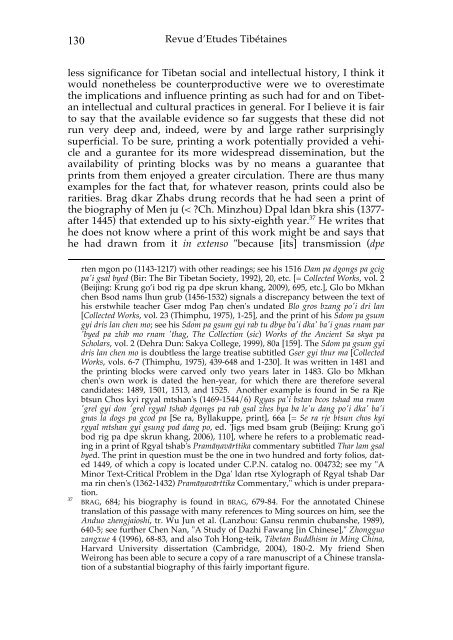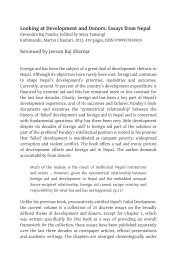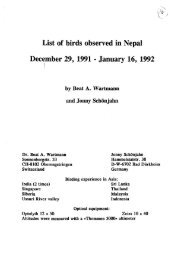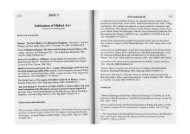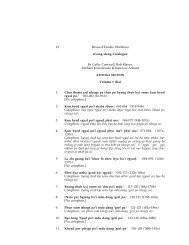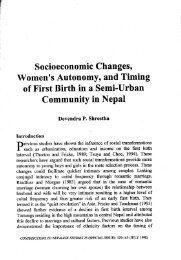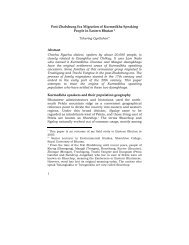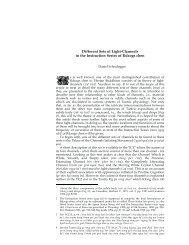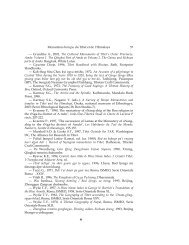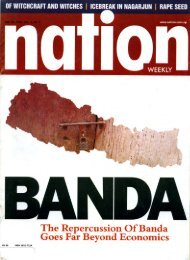Some Remarks on the Textual Transmission and Text of Bu ston
Some Remarks on the Textual Transmission and Text of Bu ston
Some Remarks on the Textual Transmission and Text of Bu ston
Create successful ePaper yourself
Turn your PDF publications into a flip-book with our unique Google optimized e-Paper software.
130<br />
Revue d’Etudes Tibétaines<br />
less significance for Tibetan social <strong>and</strong> intellectual history, I think it<br />
would n<strong>on</strong>e<strong>the</strong>less be counterproductive were we to overestimate<br />
<strong>the</strong> implicati<strong>on</strong>s <strong>and</strong> influence printing as such had for <strong>and</strong> <strong>on</strong> Tibetan<br />
intellectual <strong>and</strong> cultural practices in general. For I believe it is fair<br />
to say that <strong>the</strong> available evidence so far suggests that <strong>the</strong>se did not<br />
run very deep <strong>and</strong>, indeed, were by <strong>and</strong> large ra<strong>the</strong>r surprisingly<br />
superficial. To be sure, printing a work potentially provided a vehicle<br />
<strong>and</strong> a gurantee for its more widespread disseminati<strong>on</strong>, but <strong>the</strong><br />
availability <strong>of</strong> printing blocks was by no means a guarantee that<br />
prints from <strong>the</strong>m enjoyed a greater circulati<strong>on</strong>. There are thus many<br />
examples for <strong>the</strong> fact that, for whatever reas<strong>on</strong>, prints could also be<br />
rarities. Brag dkar Zhabs drung records that he had seen a print <strong>of</strong><br />
<strong>the</strong> biography <strong>of</strong> Men ju (< ?Ch. Minzhou) Dpal ldan bkra shis (1377-<br />
after 1445) that extended up to his sixty-eighth year. 37 He writes that<br />
he does not know where a print <strong>of</strong> this work might be <strong>and</strong> says that<br />
he had drawn from it in extenso "because [its] transmissi<strong>on</strong> (dpe<br />
37<br />
rten mg<strong>on</strong> po (1143-1217) with o<strong>the</strong>r readings; see his 1516 Dam pa dg<strong>on</strong>gs pa gcig<br />
pa'i gsal byed (Bir: The Bir Tibetan Society, 1992), 20, etc. [= Collected Works, vol. 2<br />
(Beijing: Krung go’i bod rig pa dpe skrun khang, 2009), 695, etc.], Glo bo Mkhan<br />
chen Bsod nams lhun grub (1456-1532) signals a discrepancy between <strong>the</strong> text <strong>of</strong><br />
his erstwhile teacher Gser mdog Paṇ chen's undated Blo gros bzang po'i dri lan<br />
[Collected Works, vol. 23 (Thimphu, 1975), 1-25], <strong>and</strong> <strong>the</strong> print <strong>of</strong> his Sdom pa gsum<br />
gyi dris lan chen mo; see his Sdom pa gsum gyi rab tu dbye ba'i dka' ba'i gnas rnam par<br />
'byed pa zhib mo rnam 'thag, The Collecti<strong>on</strong> (sic) Works <strong>of</strong> <strong>the</strong> Ancient Sa skya pa<br />
Scholars, vol. 2 (Dehra Dun: Sakya College, 1999), 80a [159]. The Sdom pa gsum gyi<br />
dris lan chen mo is doubtless <strong>the</strong> large treatise subtitled Gser gyi thur ma [Collected<br />
Works, vols. 6-7 (Thimphu, 1975), 439-648 <strong>and</strong> 1-230]. It was written in 1481 <strong>and</strong><br />
<strong>the</strong> printing blocks were carved <strong>on</strong>ly two years later in 1483. Glo bo Mkhan<br />
chen's own work is dated <strong>the</strong> hen-year, for which <strong>the</strong>re are <strong>the</strong>refore several<br />
c<strong>and</strong>idates: 1489, 1501, 1513, <strong>and</strong> 1525. Ano<strong>the</strong>r example is found in Se ra Rje<br />
btsun Chos kyi rgyal mtshan's (1469-1544/6) Rgyas pa'i bstan bcos tshad ma rnam<br />
'grel gyi d<strong>on</strong> 'grel rgyal tshab dg<strong>on</strong>gs pa rab gsal zhes bya ba le'u dang po'i dka' ba'i<br />
gnas la dogs pa gcod pa [Se ra, Byllakuppe, print], 66a [= Se ra rje btsun chos kyi<br />
rgyal mtshan gyi gsung pod dang po, ed. 'Jigs med bsam grub (Beijing: Krung go'i<br />
bod rig pa dpe skrun khang, 2006), 110], where he refers to a problematic reading<br />
in a print <strong>of</strong> Rgyal tshab's Pramāṇavārttika commentary subtitled Thar lam gsal<br />
byed. The print in questi<strong>on</strong> must be <strong>the</strong> <strong>on</strong>e in two hundred <strong>and</strong> forty folios, dated<br />
1449, <strong>of</strong> which a copy is located under C.P.N. catalog no. 004732; see my "A<br />
Minor <strong>Text</strong>-Critical Problem in <strong>the</strong> Dga' ldan rtse Xylograph <strong>of</strong> Rgyal tshab Dar<br />
ma rin chen's (1362-1432) Pramāṇavārttika Commentary," which is under preparati<strong>on</strong>.<br />
BRAG, 684; his biography is found in BRAG, 679-84. For <strong>the</strong> annotated Chinese<br />
translati<strong>on</strong> <strong>of</strong> this passage with many references to Ming sources <strong>on</strong> him, see <strong>the</strong><br />
Anduo zhengjaioshi, tr. Wu Jun et al. (Lanzhou: Gansu renmin chubanshe, 1989),<br />
640-5; see fur<strong>the</strong>r Chen Nan, "A Study <strong>of</strong> Dazhi Fawang [in Chinese]," Zh<strong>on</strong>gguo<br />
zangxue 4 (1996), 68-83, <strong>and</strong> also Toh H<strong>on</strong>g-teik, Tibetan <strong>Bu</strong>ddhism in Ming China,<br />
Harvard University dissertati<strong>on</strong> (Cambridge, 2004), 180-2. My friend Shen<br />
Weir<strong>on</strong>g has been able to secure a copy <strong>of</strong> a rare manuscript <strong>of</strong> a Chinese translati<strong>on</strong><br />
<strong>of</strong> a substantial biography <strong>of</strong> this fairly important figure.


